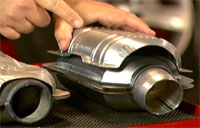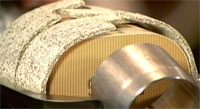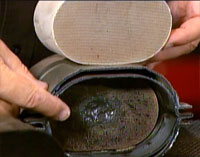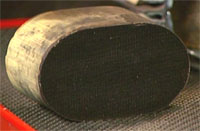Cat Converter Issues
 Extremely important but extremely misunderstood, that’s the lot of catalytic converters on your car. Most people don’t know what they look like or how they work. Here we have a typical catalytic converter. It’s made up of several different pieces: we have this outer heat shield that helps keep it cool and keep the things around it cool; then part of the shell and inside the shell we have connectors that allow us to adapt it to the pipes underneath the car; then we have this ceramic brick that’s held in place by heat resistant material.
Extremely important but extremely misunderstood, that’s the lot of catalytic converters on your car. Most people don’t know what they look like or how they work. Here we have a typical catalytic converter. It’s made up of several different pieces: we have this outer heat shield that helps keep it cool and keep the things around it cool; then part of the shell and inside the shell we have connectors that allow us to adapt it to the pipes underneath the car; then we have this ceramic brick that’s held in place by heat resistant material.
 How does a catalytic converter work? Well, catalytic converters work by trapping air, trapping oxygen in the exhaust coming out of the engine. What that does is similar to like what you would do if you were starting a campfire or a fire in the fireplace. You’ve got the kindling and it’s glowing but it won’t burst into flames. When you apply a lot of oxygen to a catalytic converter it works just like blowing on those embers: they burst into flames. A catalytic converter in turn gets extremely hot when it has a lot of oxygen coming into it, and that extreme heat re-burns everything that comes out of the engine, including smoke. So you may have a situation where you have a car that burns a lot of oil but doesn’t smoke. That’s because the converter consumes it and you don’t see it.
How does a catalytic converter work? Well, catalytic converters work by trapping air, trapping oxygen in the exhaust coming out of the engine. What that does is similar to like what you would do if you were starting a campfire or a fire in the fireplace. You’ve got the kindling and it’s glowing but it won’t burst into flames. When you apply a lot of oxygen to a catalytic converter it works just like blowing on those embers: they burst into flames. A catalytic converter in turn gets extremely hot when it has a lot of oxygen coming into it, and that extreme heat re-burns everything that comes out of the engine, including smoke. So you may have a situation where you have a car that burns a lot of oil but doesn’t smoke. That’s because the converter consumes it and you don’t see it.
 Now what could go wrong with a converter? Well, lot of things. Number one: physical damage, and physical damage often breaks up the inside of the converter and it rattles and it fails emissions. Another problem, if we look at this block of good material, the ceramic material inside the converter, we can look right straight through it if we were to hold it up to the light. We look at this one down here, this one has melted because it overheated, and it overheated because too much fuel got into the converter.
Now what could go wrong with a converter? Well, lot of things. Number one: physical damage, and physical damage often breaks up the inside of the converter and it rattles and it fails emissions. Another problem, if we look at this block of good material, the ceramic material inside the converter, we can look right straight through it if we were to hold it up to the light. We look at this one down here, this one has melted because it overheated, and it overheated because too much fuel got into the converter.
 So one thing to remember, you never replace a converter without repairing the problem that caused it to go bad, because it will just go bad again, and that includes things like this one over here that’s just completely saturated with liquid oil.
So one thing to remember, you never replace a converter without repairing the problem that caused it to go bad, because it will just go bad again, and that includes things like this one over here that’s just completely saturated with liquid oil.
Well, all of these things tell us that what we need to do if we have a catalytic converter problem. Number one, we have to test it properly. Number two, we have to find out why it went bad. Number three, we have to fix the problem before we replace the converter.
If you have a question or comment, write to me or send me a DVD video of your question and you might see yourself on TV.
The address is MotorWeek, Owings Mills, MD, 21117.





